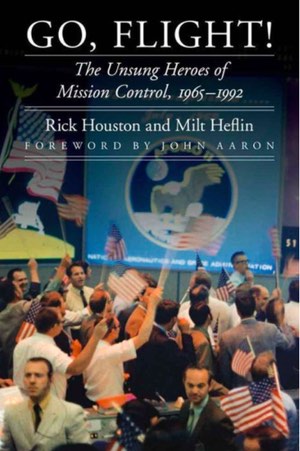Review: Go Flight!by Jeff Foust
|
| “Basically, we found out that the people at MIT, Stanford, and those kinds of schools were absolutely brilliant, but they weren’t great team players,” Kranz recalled of early flight controllers. |
That might lead people to believe that the men and women of Mission Control are an interchangeable, homogenous bunch. That wasn’t the case, at the very least, during the early years of the space program. As Rick Houston and Milt Heflin recount in Go Flight!, the men who helped create and staff Mission Control in its early years were a diverse group, united in a quest to win the Space Race with the Soviet Union and achieve John F. Kennedy’s goal of reaching the Moon by the end of the decade.
Go Flight! is, at its heart, an oral history of the first decade of Mission Control in Houston. Co-author Rick Houston interviewed dozens of people who worked there, getting their life stories and anecdotes—serious and humorous—about working there. The book’s other co-author, Milt Heflin, is a veteran of Mission Control who served a flight director, embedding his own experiences and insights into the book.
The people who worked in Mission Control in those early years came from a variety of backgrounds, some ex-military and others recent college graduates. “Basically, I got farm boys, first in the family ever to go to college, so they had a hell of a work ethic,” Kranz recalled. Few were from elite colleges, he recalled. “Basically, we found out that the people at MIT, Stanford, and those kinds of schools were absolutely brilliant, but they weren’t great team players.”
And being a team player was important. Controllers had to be experts on their systems, but had to work together during a mission. The interviews in the book make clear the challenges they faced to resolve problems under time pressure, with missions, and lives, on the line. The most successful thrived on it. Kranz, in the book, recalled that one thing he liked about working a mission was the binary nature of decision making: go or no-go, and nothing else. Or, to paraphrase the line most closely associated with him, “maybe” was not an option.
| To paraphrase the line most closely associated with him, “maybe” was not an option. |
Most of the book recounts the work of those in Mission Control from the early Gemini missions, when the new Houston center started up, through the Apollo program. That includes the drama of Apollo 13 and the euphoria of Apollo 11, but also the challenges faced by other missions as Mission Control the institution, and the people who worked there, matured in the early years of the space age.
If there’s a drawback to Go Flight!, it’s that, despite the subtitle, there’s not much about Mission Control after the Apollo program. Only one chapter is devoted to the shuttle program and the changes it brought to Mission Control, such as the entry of women into what has been a male-only domain. Compared to the rest of the book, it seems a bit rushed.
Perhaps at some point Houston and Heflin can revisit the shuttle era, as well as the station era and the changes it brought, like making Mission Control a 24/7/365 enterprise after decades of running missions that lasted days or weeks. That would, in the process, introduce us to another group of people who aren’t known by name, but are essential to human spaceflight today.
